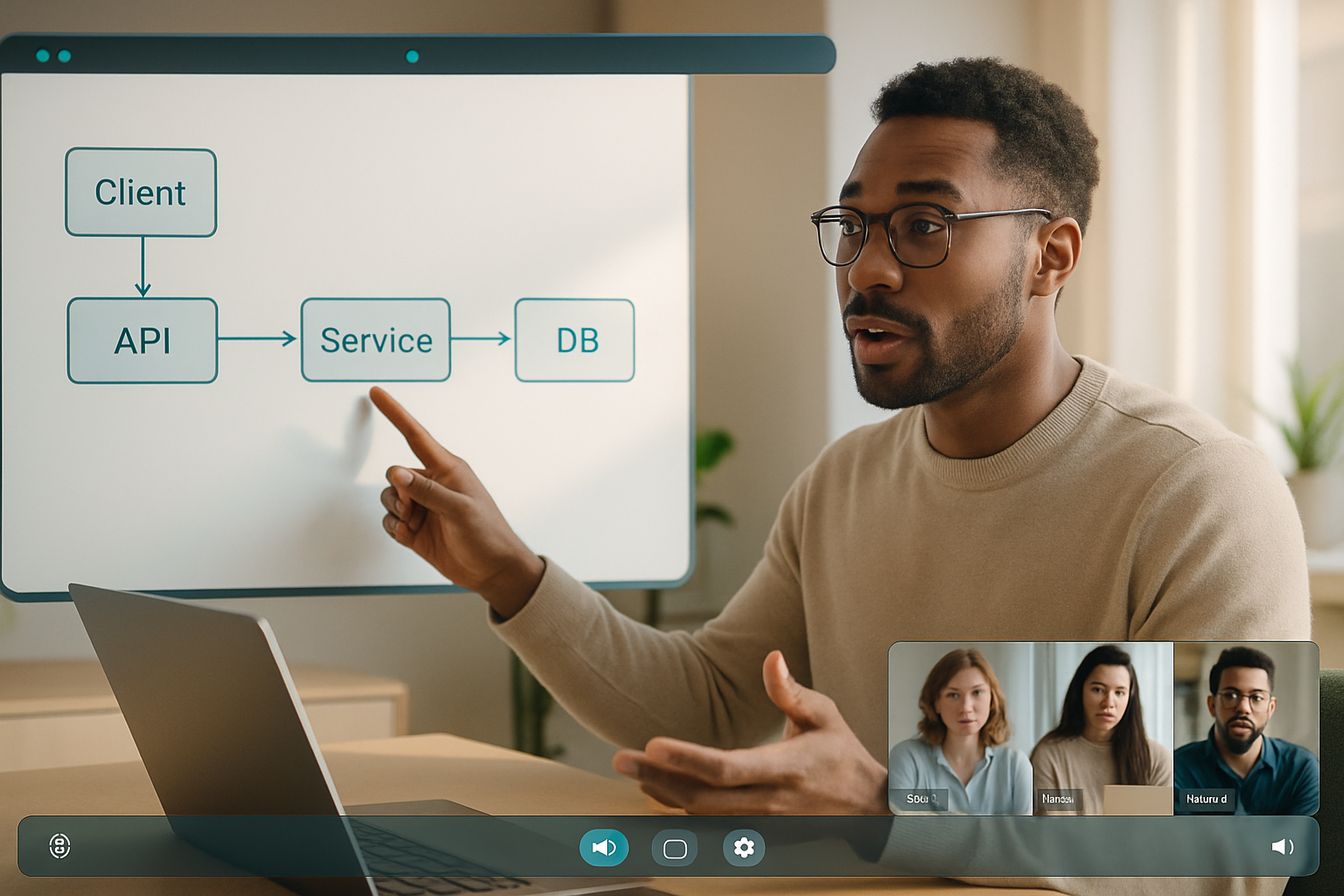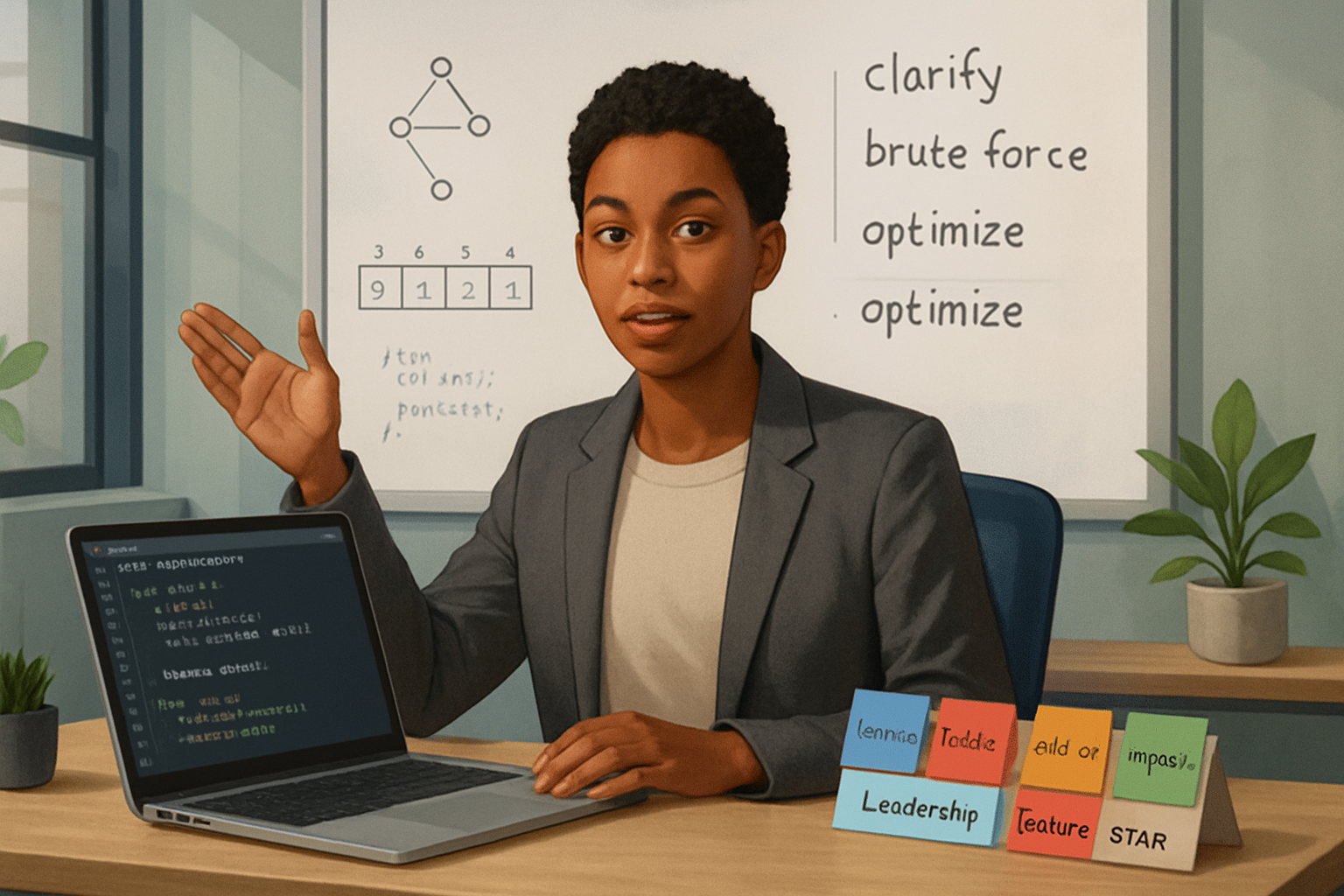· career · 7 min read
Mastering the Art of Technical Communication: A Key to Success at OpenAI
Learn how to communicate clearly and confidently in technical interviews at OpenAI. This guide gives concrete frameworks, sample language, mock dialogues, and practice drills to help you articulate your thought process, handle ambiguity, and demonstrate teamwork during coding challenges and discussions.

Outcome first: if you can explain what you’re doing, why you’re doing it, and what tradeoffs you considered, you’ll be more likely to pass technical interviews at OpenAI - and to succeed once you’re hired. Read this post and you’ll leave with a repeatable framework, ready-to-use phrases, and practice drills to sharpen how you present ideas in both coding challenges and collaborative conversations.
Why technical communication matters at OpenAI
OpenAI hires people who solve hard problems and then explain their solutions so cross-functional partners can act on them. Good code alone is not enough. You must also:
- Convey assumptions and constraints. Short, clear statements save time.
- Highlight tradeoffs and failure modes. This builds trust.
- Show how you collaborate: give credit, ask for help, incorporate feedback.
Clear technical communication converts ideas into impact. It’s how research, engineering, product, and safety teams move together. If you can make complexity understandable, you become multiply useful.
(If you want details on OpenAI’s roles and interview structure, see the careers page: https://openai.com/careers.)
A step-by-step framework to use in live technical interviews
Use this framework whenever you’re handed a problem. It gives structure to your talk-through and makes your intentions visible.
- Restate and clarify (30–90 seconds)
- Immediately restate the problem in your own words. Keep it concise.
- Ask targeted clarifying questions about inputs, outputs, constraints, and success metrics.
What to say:
- “To make sure I understand: we get X as input, and we should return Y. Is that correct?”
- “Are there constraints on time, memory, or libraries we may use?”
Why it works: restating buys you thinking time and demonstrates you’re aligning assumptions with the interviewer.
- Propose an outline / strategy (60–180 seconds)
- Give a high-level plan before writing any code. Use a 2–3 bullet approach: algorithm idea, data structures, complexity targets.
- If there are multiple approaches, briefly mention alternatives and pick one with an explicit reason.
What to say:
- “My plan: (1) do a linear scan to collect candidates, (2) use a hash map to count frequency, and (3) return the highest-frequency item. This will be O(n) time and O(n) space. The alternative is sorting, which is O(n log n) but lower constant factors if n is small.”
Why it works: it signals design thinking and gives the interviewer a chance to steer you if they wanted a different approach.
- Code while narrating (think‑aloud)
- Implement step-by-step, narrating your intent. Short sentences for key actions. Longer sentences for tradeoffs or tricky logic.
- Comment on invariants and edge cases as you add them.
Example narration lines:
- “I’ll start by initializing a map to count occurrences.”
- “Careful here: if input can be null, I’ll guard against that to avoid exceptions.”
Think-aloud is essential; it turns silent typing into a visible reasoning process. See the think-aloud protocol for more context: https://en.wikipedia.org/wiki/Think-aloud_protocol.
- Test, debug, and iterate (2–5 minutes)
- Walk through 2–4 test cases out loud: normal case, edge case, and worst case.
- If a bug appears, narrate the hypothesis, the experiment, and the fix.
Example test narration:
- “Test: [1, 2, 2, 3] should return 2. Let’s step through: after scanning, map is {1:1,2:2,3:1} so we return 2. Good.”
Why it works: interviewers watch how you validate and when you accept results.
- Discuss complexity, tradeoffs, and scaling (1–2 minutes)
- Explicitly state time and space complexity. Mention how the approach behaves with big inputs, networked systems, or distributed contexts.
- If relevant, describe monitoring, failure modes, or data privacy considerations.
Example lines:
- “This is O(n) time and O(n) memory. If n is huge we could stream and use approximate counting like HyperLogLog, trading exactness for memory.”
- Summarize and propose next steps (30–60 seconds)
- Give a crisp summary: “We solved X with Y approach; main risk is Z; next steps would be …”
Example:
- “Summary: linear pass with hashmap; handles typical inputs efficiently; if memory is constrained we can stream with approximations. Next, I’d write unit tests and add input validation.”
Why it works: closure shows you can move from prototype to production thinking.
Sample live transcript (short)
Interviewer: “Write a function that finds the most frequent element in an array.”
Candidate: “Just to confirm: array can be empty? Are elements integers only?”
Interviewer: “Integers only; array has at least one element.”
Candidate: “Great. Plan: one pass to count frequencies in a hash map, then return the max. O(n) time, O(n) space. I’ll implement that now.”
[Candidate types code, narrating each step and guarding an edge case. Then runs quick examples.]
Candidate: “Edge cases: ties return any of the top elements; if we need deterministic behavior we could prefer the earliest occurrence and track indices.”
Interviewer: “Looks good.”
Short. Clear. Structured.
Handling ambiguity and unknowns (say this, not that)
How to admit you don’t know, and still add value:
- Good: “I don’t know the exact API behavior; here’s how I would check and a fallback plan.”
- Better: “I haven’t used X in production recently. I’d verify its boundary cases; alternately I can design this to be implementable with standard primitives so we avoid a risky dependency.”
Avoid: “I don’t know” then silence. Always pair the admission with a next step.
Behavioral / teamwork answers: use STAR, then translate to technical collaboration
Structure behavioral answers with STAR: Situation, Task, Action, Result. But for technical collaboration, add a short technical appendix: decisions made, tradeoffs considered, and what you learned.
Example (abridged):
- Situation: We needed to reduce inference latency on a critical endpoint.
- Task: Reduce p95 latency by 40% without losing accuracy.
- Action: I profiled the pipeline, identified a bottleneck in preprocessing, implemented memoization and async batching, and coordinated rollout with the infra team. I kept stakeholders updated weekly and created a rollback plan.
- Result: p95 latency dropped 45% with no accuracy loss; rollout was completed with a single minor rollback that taught us better load-air-gap procedures.
Technical appendix (short): “We traded higher memory use for latency reductions; to mitigate memory pressure we added eviction metrics and an adaptive threshold.”
Why this works: it shows the combination of interpersonal coordination and technical judging.
Reference on STAR method: https://www.themuse.com/advice/interview-preparation-star-method
Concrete language: templates and phrases
Use these to structure live speech. Keep them short.
Opening / clarifying:
- “Let me restate the problem to ensure I’m aligned: …”
- “Can you confirm the expected behavior for X?”
Outlining approach:
- “High level plan: …”
- “I see two options: A (pros/cons) and B (pros/cons). I’ll start with A.”
While coding:
- “I’m adding this guard to avoid exceptions on null input.”
- “This loop maintains invariant Y.”
Handling mistakes:
- “That didn’t work; hypothesis is X. I’ll try Y to confirm.”
- “I overlooked edge case Z; I’ll add a test and fix it now.”
Wrapping up:
- “Summary: … main risk: … next steps: …”
Use language that exposes your reasoning. It’s not theater. It’s a map of your mind.
Teamwork signals specific to OpenAI-style roles
OpenAI values cross-disciplinary collaboration and careful consideration of safety and societal impact. When discussing teamwork, emphasize:
- Interaction: how you solicited domain input (research, product, safety).
- Reproducibility: how you documented experiments, tests, and rollback plans.
- Safety tradeoffs: how you considered misuse, robustness, and monitoring.
Example sentence: “I paired with a researcher to ensure the evaluation metric reflected safety constraints; we added unit tests and an integration test that simulates adversarial inputs.”
Practice drills to improve your technical communication
- Record 15-minute mock interviews and listen for silent pauses longer than 3 seconds - replace them with short clarifying statements.
- Pair-program with someone who will ask you “Why?” after each decision.
- Do a 5-minute elevator pitch for three projects: challenge, your role, impact, and one technical tradeoff.
- Practice the 6-step framework on 10 classic interview problems until narration feels natural.
Resources: pair-programming benefits and guidance: https://martinfowler.com/articles/on-pair-programming.html
A short preparation checklist
- Prepare 3 crisp project stories (challenge, action, impact).
- Practice think-aloud while coding 10 problems.
- Learn to restate problems and ask 3 clarifying questions quickly.
- Memorize 5 go-to phrases for each stage (clarify, outline, code, test, summarize).
- Be ready to describe safety and monitoring considerations for your designs.
Closing: what success looks like
Success is not just a correct solution. It’s a correct solution you can explain, justify, and hand off. Say what you did. Explain why you did it. Anticipate how it could fail. Do that consistently, and you’ll stand out in interviews at OpenAI and beyond.
References
- OpenAI Careers: https://openai.com/careers
- Think-aloud protocol: https://en.wikipedia.org/wiki/Think-aloud_protocol
- STAR interview method: https://www.themuse.com/advice/interview-preparation-star-method
- Pair programming: https://martinfowler.com/articles/on-pair-programming.html



